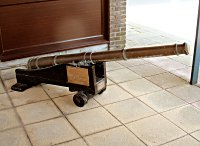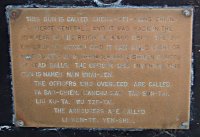Location
Two guns standing either side of the front door to the Senior Rates Mess at HMS Excellent.

Plaque

PRESENTED
BY
COMdr DODGSON DAINTREE 1904
FROM NAVAL COMMISSIONERS HOUSE
WEI-HAI-WEI
Inscription (On right hand gun only)
THIS GUN IS CALLED SHENG-WEI-KIANG CHIUN
FIERCE GENERAL AND IT WAS MADE IN THE
10TH YEAR OF THE REIGN OF KANG HSI THE 2
EMPEROR OF CHINA AND IT CAN HOLD EIGHT OR
NINE OUNCES OF GUN-POWDER AND EIGHTEEN OUNCES
OF LEAD BALLS. THE OFFICER WHO INVENTED THE
GUN IS NAMED NAN WHAI-JEN.
THE OFFICERS WHO OVERSEED ARE CALLED
FA BAO-CHIEN, MANCHU MAN, TAO SUN-TAI,
LIU KU-TA, WU TZE-TAI
THE ARMOURERS ARE CALLED
LI WEN-TE, YEN-SHI
Further Information
The Commander Daintree referred to on the brass plate affixed to both guns was a Commander John Dodson Daintree R.N. who was Officer in Charge, Wei Hai Wei Naval Establishments and Queens Harbour Master Wei Hai Wei from December 1901 to March 1904. The title of Naval Commissioner lapsed in 1901 when the government of the leased area was transferred from naval administration to civilian and his title changed to "Officer in Charge" and Commander Daintree was appointed the first holder of the new post.
The location of Wei Hai Wei is shown on the map below.
The guns were positioned at the entranceway to the Naval Commissioners Residence at the Naval Base on Liu Kung Tao Island, which lays some one and half miles offshore from the mainland of Shantung Province, North China, but the leased territory as a whole was referred to as Wei Hai Wei, this being the name of the walled town on the mainland adjacent to the island.
Research almost certainly indicates the guns were removed from their storage in the Imperial Arsenal located at the Sun-Chi-Men (Gate) surrounding the Walled City, Peking (Beijing) in August 1900 during the Boxer Rebellion (1900-1901), following the raising of the Siege of Peking. They were "requisitioned" by a Captain A.A.Barnes, Adjutant of the 1st. Chinese Regiment or Wei Hai Wei Regiment as it was more commonly known, which had been raised in the leased territory as a Defence Force in 1898 but had been deployed in the column formed to relieve Peking, and he discovered the guns in the arsenal when seeking an artillery piece to serve as a "Noon Day" gun at the Regiment's Barracks at Wei Hai Wei, and they together with other ordnance were subsequently carried off to their depot when the Regiment was released from the campaign in late October 1900 to resume their normal role as a Defence Force. The guns were then presented to the Naval Commissioner (who was still in post at this time), together with other ancient ordnance from the arsenal located on the island of Liu Kung Tao.
On being relieved on station, Commander Daintree caused the guns to be shipped to the United Kingdom and subsequently he presented them to HMS Excellent. Commander Daintree was a Navigation rather than a Gunnery specialist so it is something of a mystery why HMS Excellent was chosen to receive them. It could be because HMS Excellent was still under development as the Gunnery School of the Royal Naval and as was normal with military establishments, happy to acquire "trophies" from ships returning from far flung "incidents and skirmishes" around the Empire or from other sources.
Alternatively, it could be connected with the fact that the Captain of HMS Excellent at the time was Captain Percy Scott who as Captain of HMS Terrible, an armoured cruiser, was closely involved in providing men and guns for the Naval Brigade which had been hastily formed at the outset of the Boxer Rebellion to go to the relief of Peking and he would have known Commander Daintree in his capacity as O.I.C. the Naval Base on Liu Kung Tao, where naval shipwrights had manufactured and fitted wheels designed by Captain Scott to naval ordnance supplied by his ship, HMS Terrible and subsequently deployed by the Naval Brigade in the ensuing campaign.
The officer referred to on the plate affixed to one of the guns as being the inventor, Nan Whai-Jen (this was his Chinese name) was a Jesuit Missionary from the Low Countries called Ferdinand Verbiest (1623-1685) who was also a mathematician, scientist and engineer and because of these skills was tasked by Emperor Kang Hsi (1662-1722) to improve the design and expand the capability of his artillery. Emperor Kang Hsi was the longest reigning Emperor of China, ruling for sixty years, from 1662 to 1722, therefore according to the plate the guns would have been manufactured in 1672.
Before February 1895, when it was captured by the Japanese, Wei Hai Wei had been held by the Chinese and used as a naval base. The Japanese remained there until May 1898, when it was leased by the British Government from China. Initially the lease was to run for so long as Russia occupied Port Arthur, but when Japan threw the Russians out from there in 1905 she justified the continuance of the lease by maintaining the situation was the same, only the occupying country had changed! As part of the Japanese conditions for vacating Wei Hai Wei and returning it to China she demanded payment of a huge indemnity of £35 million pounds. The last instalment was finally paid with Britain's support on 7 May 1898 and on 23 May the Japanese troops were evacuated and the Chinese flag raised. On the following day, 24 May 1898, Great Britain took up the negotiated lease of the designated territory.
The British had exclusive rights over the area, and was represented by a commissioner. It had the right to erect fortifications and station troops in that part of the peninsula. Chinese war-vessels were allowed to use the anchorage despite the British lease. Wei-hai-wei was made the headquarters of a native Chinese regiment, formed in 1899 in the pay of Great Britain, and organized and led by British officers; but this regiment was disbanded in 1906. Wei-hai-wei was finally handed back to China on October 1st 1930 under an agreement made some eight years earlier, though certain locations and buildings including the naval base on Liu Kung Tao was leased back for a period of ten years, with the option of an extension of a further ten years after that.
Thus there was a continuing British presence in the area, especially as regards commerce and the China Fleet, which used the naval base from May to October each year for exercises, drills and recreation until November 1940, when the Chinese Puppet Government refused to renew the lease under instructions from their Japanese masters, who by this time were in occupation of the adjacent mainland and other territory of China together with those parts of the Liu Kung Tao island which had been handed back to the Chinese Government in 1930.
As part of the Lease Treaty, Chinese warships of their Northern Fleet were permitted free use of the anchorage and they had their own facilities on the island and Great Britain undertook to train her officers and so therefore did not have exclusive rights over all the area, only the mainland.
[This information is published here courtesy of Ronald Childs, retired Lieutenant Commander, Royal Navy]

